Finishes
Painting
The selection of the paint or coating system should be done at the outset of the project as both the colour and finish will impact detailing decisions and therefore, cost. If a high gloss finish is desired, it will reveal every minute imperfection in the steel. Flat finishes are more accommodating. Light coloured paints will quickly reveal corrosion and dirt. Thin finishes will reveal surface imperfections. Thicker coatings, such as intumescent fire protection can cover or conceal imperfections as well as fine details.
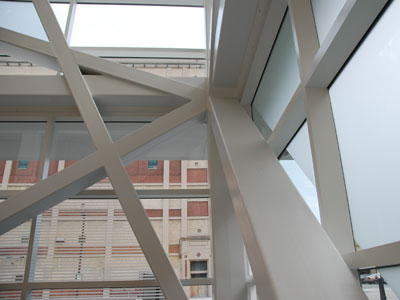 |
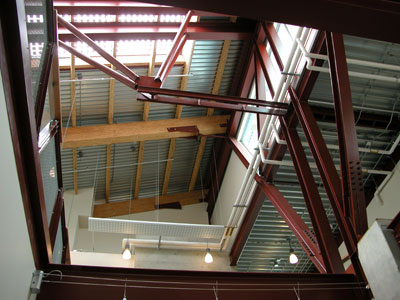 |
The painted finish on this HSS structure at a Wisconsin Bus Terminal required a high level of surface preparation to suit the all welded structure. The white paint is also less forgiving than a darker colour. |
The wide flange sections and detailing using a combination of bolted and welded connections permitted an easier scenario for surface preparation in advance of painting the steel structure. |
General Notes About Painting
Steel exposed to view is generally painted for appearance. A one-coat paint system, such as performance specification CISC/CPMA 1-73a, is sufficient for standard warehouse structures that will not be top coated (Standard Structural Steel and AESS 1). Since the building environment is controlled no corrosion occurs once the building is enclosed. These buildings perform adequately throughout the country. One-coat systems are referenced in Clause 28.8.6 of CSA Standard S16-01.
Steel buildings require NO paint when the steel is hidden behind drywall and suspended ceilings. The humidity in such buildings is below the threshold limit for corrosion to steel to occur (Clause 6.6.2 of CSA Standard S16-01 and S16-09). Buildings that have exceptionally high humidity such as swimming pools and water treatment plants are exceptions and should be treated as exterior exposed steel.
Steel exposed to view that will be top coated for appearance (AESS 2 and above) requires a prime coat for adhesion. A fast dry primer, such as CISC/CPMA 2-75, is sufficient to provide the necessary base. To ensure that this system will perform for longer periods a greater degree of cleanliness is required by the specification. Hence AESS requires surface preparation to a minimum SP-6. Consultants must ensure that the finish coats are compatible with the primer. Each paint system often has its own primer. Alkyd primers are acceptable but epoxy primers are not. Once the building is enclosed no corrosion occurs.
Structural steel that is exposed to view and the elements on the exterior of buildings requires more thorough cleaning and finishing to ensure long-term performance. Higher degrees of cleanliness along with better quality multi-coat paints should be considered under these circumstances. Epoxy systems over compatible primers are usually most suitable. Urethanes should be used when wear is a consideration.
Tender documents should include the following information to ensure good quality coating systems:
• identification of the members to be painted
• a specification for the degree of cleanliness required to ensure performance such as SSPC Surface Preparation Standards
• compatible primer, intermediate and finish paints and if applicable:
- the manufacturer's product identification
- the average dry film thickness per coat
We recommend that you review the painting with your local fabricator or supplier to ensure that the most suitable system is chosen for your specific application.
Shop versus Site Painting
The painting of an AESS structure can take place in the fabrication shop or on the site. Many fabricators can offer shop painting which can ensure a more consistent, higher quality finish. Naturally it is expected for the paint finish to be free of drips and runs. Access to the installed structure for paint applications can be a logistical issue. Shop applied paint finishes will likely need to be touched up after erection, but this is less problematic than the complete painting of the structure on site which rarely occurs.
Pre-painted structures will require extra care and protection during transportation, handling and erection. Pre-painted structures will be more in need of "just in time" delivery to the site to prevent site generated damage. Pre-painted structures may also require better staging areas on site - again to prevent damage to the painted finishes.
The careful preparation of the steel, including the basic removal of sharp edges (Characteristic 1.2) will allow for a more even application of the paint and better coverage on the corners. The spray application of the product on sharp corners is difficult and if these are not ground or rounded off can lead to premature wear on the edges of the structure. If in an exterior application, this can lead to corrosion.
Primers
The selection of the primer will be a function of the choice of the finish coating. Not all finish coating systems take the same base primer, so revisions in the final finish type may require remedial correction of primers to ensure compatibility. Care in application of the primer is important as any drips and runs will translate through both paint and intumescent coating finishes. Additionally, not all finish systems require a primer. If not required, this can represent a cost and time saving.
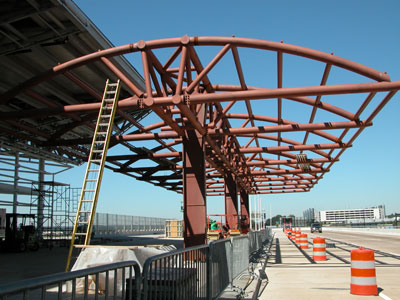 |
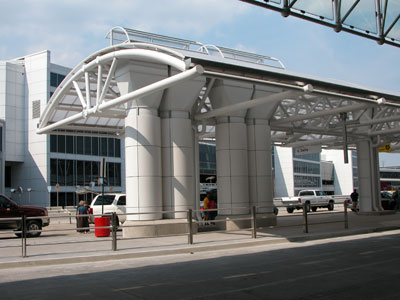 |
As this canopy at the Baltimore Washington International Airport was located outside, it warranted priming both to protect the steel from corrosion during erection, and to ensure a proper bond to the paint. |
The finished canopy retains some of the exposed steel, however you can see that the column supports have been clad. As this is a exterior environment, the columns were primed even though they would eventually be covered. |
Where steel is to be welded, no primer is to be applied. The surface of the steel must be bare and clean for welding to take place. Even if the member is primed in preparation for painting or the application of an intumescent coating, the primer will be held back from the connection.
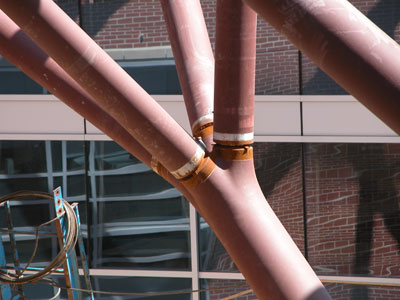 |
Although the main members have been primed in preparation for a high gloss paiinted finish, the strip adjacent to the weld has not been primed. The corrosion that you see will be removed prior to welding. Once the weld is complete, primer will be applied on site prior to painting. Due to the high expectations of the gloss finish, this structure was painted on site rather than in the shop. Access was possible, given the limited height of the space. |
